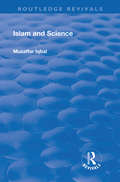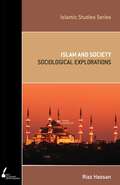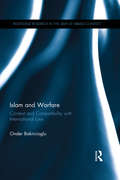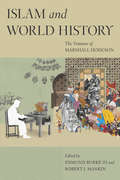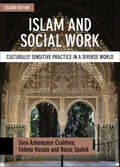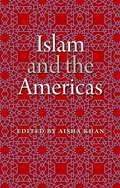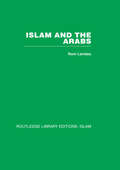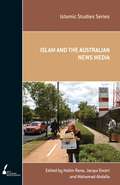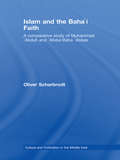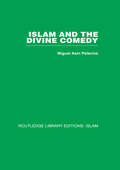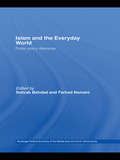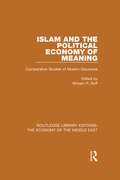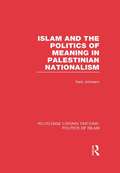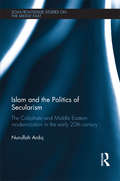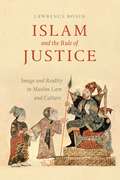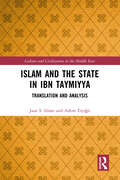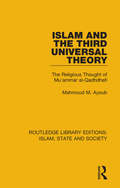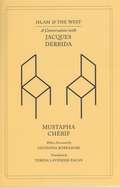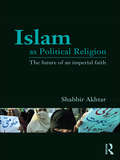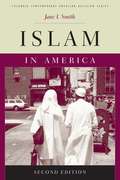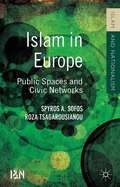- Table View
- List View
Islam and Science: Volume 1 (Routledge Revivals Ser.)
by Muzaffar IqbalThis title was first published in 2002. This text seeks to provide the necessary background for understanding the contemporary relationship between Islam and modern science. Presenting an authentic discourse on the Islamic understanding of the physical cosmos, Muzaffar Iqbal explores God's relationship to the created world and the historical and cultural forces that have shaped and defined Muslim attitudes towards science. What was Islamic in the Islamic scientific tradition? How was it rooted in the Qur'anic worldview and whatever happened to it? These are some of the facets of this account of a tradition that spans eight centuries and covers a vast geographical region. Written from within, this ground-breaking exploration of some of the most fundamental questions in the Islam and science discourse, explores the process of appropriation and transformation of the Islamic scientific tradition in Europe during the three centuries leading up to the Scientific revolution.
Islam and Society: Sociological Explorations (Islamic Studies Series)
by Riaz HassanThe central focus of this volume is to explore and highlight the nexus between the ideology of Islam and social and cultural milieus with the aim of reconceptualising the sacred as a socially constructed reality and not a transcendental supernatural phenomenon. From this perspective, human agency and society become the main focus for shaping, perpetuating and institutionalising religious beliefs, ideas and practices, opening up space for empirical and sociological analyses of religious phenomena. The seven essays in this volume seek to explore and examine some of the key debates in contemporary sociology of Islam. The topics explored are: social factors in the origins of Islam; social theory and Muslim society; Islam and politics in South Asia; Muslim piety; anti-Semitism; the social foundations of Muhammad's prophetic mission, with a special reference to Arab historical memory and the role of his first wife Khadija bint Khuwaylid; and the barriers to social inclusion of Australian Muslims in Australian society. Islamic Studies Series - Volume 14
Islam and Warfare: Context and Compatibility with International Law (Routledge Research in the Law of Armed Conflict)
by Onder BakirciogluThe question of how Islamic law regulates the notions of just recourse to and just conduct in war has long been the topic of heated controversy, and is often subject to oversimplification in scholarship and journalism. This book traces the rationale for aggression within the Islamic tradition, and assesses the meaning and evolution of the contentious concept of jihad. The book reveals that there has never been a unified position on what Islamic warfare tangibly entails, due to the complexity of relevant sources and discordant historical dynamics that have shaped the contours of jihad. Onder Bakircioglu advocates a dynamic reading of Islamic law and military tradition; one which prioritises the demands of contemporary international relations and considers the meaning and application of jihad as contingent on the socio-political forces of each historical epoch. This book will be of great interest to scholars and students of international law, Islamic law, war and security studies, and the law of armed conflict.
Islam and World History: The Ventures of Marshall Hodgson (Silk Roads Ser.)
by Edmund Burke III Robert J. MankinPublished in 1974, Marshall Hodgson’s The Venture of Islam was a watershed moment in the study of Islam. By locating the history of Islamic societies in a global perspective, Hodgson challenged the orientalist paradigms that had stunted the development of Islamic studies and provided an alternative approach to world history. Edited by Edmund Burke III and Robert Mankin, Islam and World History explores the complexity of Hodgson’s thought, the daring of his ideas, and the global context of his world historical insights into, among other themes, Islam and world history, gender in Islam, and the problem of Muslim universality. In our post-9/11 world, Hodgson’s historical vision and moral engagement have never been more relevant. A towering achievement, Islam and World History will prove to be the definitive statement on Hodgson’s relevance in the twenty-first century and will introduce his influential work to a new generation of readers.
Islam and social work: Culturally Sensitive Practice in a Diverse World (BASW/Policy Press titles)
by Sara Ashencaen Crabtree Fatima HusainThis unique textbook enables social work practitioners to gain a deeper understanding of how Islamic principles inform and influence the lives of Muslim populations. Designed to support work with families and faith communities, this completely revised and updated edition examines religious precepts, cosmologies, philosophies and daily practices, while acknowledging cultural variants and population heterogeneity. It includes a comprehensive update of the research literature, international case studies, and new sections on religious extremism and ageing and end-of-life. This is the only book specifically on social work with Muslim communities and provides an essential toolkit for culturally sensitive social work practice.
Islam and the Americas (New World Diasporas)
by Aisha Khan"A tour de force that underwrites and shifts the petrified image of Islam disseminated by mainstream media."--Walter D. Mignolo, author of The Darker Side of Western Modernity "Gives us an entirely different picture of Muslims in the Americas than can be found in the established literature. A complex glimpse of the rich diversity and historical depth of Muslim presence in the Caribbean and Latin America."--Katherine Pratt Ewing, editor of Being and Belonging: Muslim Communities in the United States since 9/11 "Finally a broad-ranging comparative work exploring the roots of Islam in the Americas! Drawing upon fresh historical and ethnographic research, this book asks important questions about the politics of culture and globalization of religion in the modern world."--Keith E. McNeal, author of Trance and Modernity in the Southern Caribbean In case studies that include the Caribbean, Latin America, and the United States, the contributors to this interdisciplinary volume trace the establishment of Islam in the Americas over the past three centuries. They simultaneously explore Muslims’ lived experiences and examine the ways Islam has been shaped in the "Muslim minority" societies in the New World, including the Gilded Age’s fascination with Orientalism, the gendered interpretations of doctrine among Muslim immigrants and local converts, the embrace of Islam by African American activist-intellectuals like Malcolm X, and the ways transnational hip hop artists re-create and reimagine Muslim identities. Together, these essays challenge the typical view of Islam as timeless, predictable, and opposed to Western worldviews and value systems, showing how this religious tradition continually engages with local and global issues of culture, gender, class, and race.
Islam and the Arabs
by Rom LandauOriginally published in 1958, this volume covers important aspects of Islamic history and culture: Arabia before the Prophet The Prophet The Koran and Islam The Caliphate From the Caliphate to the end of the Ottoman The Crusades The Maghreb Muslim Spain The Sharia Philosophy The Sciences Literature The Arts Problems of the Twentieth Century Arab World
Islam and the Australian News Media (Islamic Studies Series)
by Jacqui Ewart Mohamad Abdalla Dr Halim RaneFew issues have captured media headlines over the past two decades like Islam and Muslims, and much of what the Australian public knows about Islam and its followers is gleaned from the mass media. Islam and the Australian News Media tackles head-on the Australian news media's treatment of Islam and Muslims.This incisive collection brings together the research and insights of academics, editors and journalists on the representation of Islam and its impact on social relations, the newsworthiness of Muslim issues and the complexities of covering Islam. Importantly, Islam and the Australian News Media also explores how Muslim communities in Australia are responding to their image in the Australian news media.This book is a must-read for all those interested in the relationship between media and society. Islamic Studies Series - Volume 4
Islam and the Baha'i Faith: A Comparative Study of Muhammad ‘Abduh and ‘Abdul-Baha ‘Abbas (Culture and Civilization in the Middle East)
by Oliver ScharbrodtMuhammad ‘Abduh (1849-1905) was one of the key thinkers and reformers of modern Islam who has influenced both liberal and fundamentalist Muslims today. ‘Abdul-Baha (1844-1921) was the son of Baha’ullah (1817-1892), the founder of the Baha’i Faith; a new religion which began as a messianic movement in Shii Islam, before it departed from Islam. Oliver Scharbrodt offers an innovative and radically new perspective on the lives of these two major religious reformers in 19th century Middle East by placing both figures into unfamiliar terrain. While one would classify ‘Abdul-Baha, leader of a messianic movement which claims to depart from Islam, as an exponent of heresy in Islam, ‘Abduh is perceived as an orthodox Sunni reformer. This book, however, argues against the assumption that both represent two extremely opposite expressions of Islamic religiosity. It shows that both were influenced by similar intellectual and religious traditions of Islam and that both participated in the same discussions on the reform of Islam in the 19th century. Islam and the Baha'i Faith provides new insights into the Islamic background of the Baha’i Faith and into ‘Abduh’s own association with so-called heretical movements in Islam.
Islam and the Divine Comedy
by Miguel Asin PalaciosWhen first published in 1926 this book aroused much controversy. The theory expounded in the book was that Islamic sources in general, and the writings of Ibn al-`Arabi in particular, formed the basis of Dante’s poem Divine Comedy, the poem which symbolised the whole culture of medieval Christianity. The book shows how fundamental Muslim legends of the nocturnal journey and of the ascension of the Prophet Muhammed appear in Dante’s writings.
Islam and the Everyday World: Public Policy Dilemmas (Routledge Political Economy of the Middle East and North Africa #Vol. 4)
by Sohrab Behdad Farhad NomaniThis is a new examination of how Shari’a law affects public policy both theoretically and in practice, across a wide range of public policy areas, including for example human rights and family law. The process by which public policy is decided - through elections, debates, political processes, and political discourse - has an additional dimension in the Islamic world. This is because Shari'a (divine law) has a great deal to say on many mundane matters of everyday life and must be taken into account in matters of public policy. In addition, matters are complicated further by the fact that there are differing interpretations of the Shari'a and how it should be applied to contemporary social issues. Written by leading experts in their field, this is the first comprehensive single volume analysis of Islam and public policy in the English language and offers further understanding of Islam and its wider social and political implications.
Islam and the Path to Human and Economic Development
by Abbas Mirakhor Hossein AskariThis book briefly surveys the evolution of the Western concept of development, recognizing the wider dimensions of human and economic development and the role of institutions and rules, which has moved toward the vision and the path of development envisaged in Islam.
Islam and the Political Economy of Meaning: Comparative Studies of Muslim Discourse (Routledge Library Editions: The Economy of the Middle East)
by William R. RoffTo be a Muslim is to be a part of a culture with distinct beliefs, ideas, institutional forms and prescriptive roles. Yet there is a complex inter-relationship between a system of knowledge and belief, such as Islam, and the immediate political, economic and social context of its adherents. This book aims to improve understanding of Muslim social and political action by examining a broad spectrum of Muslim discourse, both written and spoken, to see how meaning is formed by context. It is a broad comparative study and examines discourses produced in opposition to government as well as those produced, in Iran or Pakistan for example, under an authoritarian Islamic state. Through cogent analyses of socio-historical contexts and textual materials from East Java, Nigeria, Iran, Pakistan, Indonesia, Malaysia, the Maghreb and Egypt, this book shows how to ‘read’ a familiar Islamic movement, period of change or textual source in a newer and better light. First published in 1987.
Islam and the Politics of Meaning in Palestinian Nationalism (Routledge Library Editions: Politics of Islam)
by Nels JohnsonThe intention of this book is to explore the relationship between an ideological idiom and the changing social movement in which it operates. The basic question is that of what roles an Islamic symbol complex played in different phases of the Palestinian nationalist movement, and what were the socio-economic factors which help to explain, and are themselves partially explained by, the appearance of these roles. Islam was ideologically ‘appropriate’ at different stages in the development of the movement, and this study examines in what way, and why. First published in 1982.
Islam and the Politics of Secularism: The Caliphate and Middle Eastern Modernization in the Early 20th Century (SOAS/Routledge Studies on the Middle East)
by Nurullah ArdicThis book examines the process of secularization in the Middle East in the late 19th and early 20th century through an analysis of the transformation and abolition of Islamic Caliphate. Focusing on debates in both the center of the Caliphate and its periphery, the author argues that the relationship between Islam and secularism was one of accommodation, rather than simply conflict and confrontation, because Islam was the single most important source of legitimation in the modernization of the Middle East. Through detailed analysis of both official documents and the writings of the intellectuals who contributed to reforms in the Empire, the author first examines the general secularization process in the Ottoman Empire from the late 18th century up to the end of the 1920s. He then presents an in-depth analysis of a crucial case of secularization: the demise of Islamic Caliphate. Drawing upon a wide range of secondary and primary sources on the Caliphate and the wider process of political modernization, he employs discourse analysis and comparative-historical methods to examine how the Caliphate was first transformed into a "spiritual" institution and then abolished in 1924 by Turkish secularists. Ardıç also demonstrates how the book’s argument is applicable to wider secularization and modernization processes in the Middle East. Deriving insights from history, anthropology, Islamic law and political science, the book will engage a critical mass of scholars interested in Middle Eastern studies, political Islam, secularization and the near-global revival of religion as well as the historians of Islam and late-Ottoman Empire, and those working in the field of historical sociology and the sociology of religion as a case study.
Islam and the Rule of Justice: Image and Reality in Muslim Law and Culture
by Lawrence RosenIn the West, we tend to think of Islamic law as an arcane and rigid legal system, bound by formulaic texts yet suffused by unfettered discretion. While judges may indeed refer to passages in the classical texts or have recourse to their own orientations, images of binding doctrine and unbounded choice do not reflect the full reality of the Islamic law in its everyday practice. Whether in the Arabic-speaking world, the Muslim portions of South and Southeast Asia, or the countries to which many Muslims have migrated, Islamic law works is readily misunderstood if the local cultures in which it is embedded are not taken into account. With Islam and the Rule of Justice, Lawrence Rosen analyzes a number of these misperceptions. Drawing on specific cases, he explores the application of Islamic law to the treatment of women (who win most of their cases), the relations between Muslims and Jews (which frequently involve close personal and financial ties), and the structure of widespread corruption (which played a key role in prompting the Arab Spring). From these case studie the role of informal mechanisms in the resolution of local disputes. The author also provides a close reading of the trial of Zacarias Moussaoui, who was charged in an American court with helping to carry out the 9/11 attacks, using insights into how Islamic justice works to explain the defendant’s actions during the trial. The book closes with an examination of how Islamic cultural concepts may come to bear on the constitutional structure and legal reforms many Muslim countries have been undertaking.
Islam and the State (Routledge Library Editions: Islam, State and Society)
by P. J. VatikiotisExamining the theoretical problems which arose when the modern European ideology of nationalism was adopted by Muslim societies organized into formally modern states, this book, first published in 1987, also deals with the practical difficulties arising from the doctrinal incompatibility between Islam and the non-Muslim concept of the territorial nation-state. It illustrates this conflict with a consideration of the record of several states in the Islamic world. It suggests that whereas the state, an organization of power, has been a most durable institution in Islamic history, the legitimacy of the nation-state has always been challenged in favour of the wide Islamic Nation, the "umma", which comprises all the faithful without reference to territorial boundaries. To this extent too, the more recent conception of Arab nationalism projects a far larger nation-state than the existing territorial states in the Arab world today. This title will be of interest to students of Middle Eastern studies.
Islam and the State in Ibn Taymiyya: Translation and Analysis (Culture and Civilization in the Middle East)
by Jaan S. Islam Adem Eryiğit"Proto-Salafist" 14th-century theologian Ibn Taymiyya is recognized as the intellectual forefather of contemporary Salafism and Jihadism. This volume offers a unique approach to the study of Ibn Taymiyya, by offering an English translation of his fundamental political treatise, The Office of Islamic Government, and shorter collections from The Collected Fatwas and The Prophetic Way, and Islamic Governance in Reconciling between the Ruler and the Ruled. The volume not only sheds light on these primary sources through translation and annotation, but also offers a theoretical analysis of Ibn Taymiyya’s thought and how his legal views can be reconciled with current trends in Islamic political theory. The analysis provides an overview of Ibn Taymiyya’s geopolitical context, and includes an original study of his normative political thought. In examining the contemporary implications of Ibn Taymiyya’s political theology, the authors explore his doctrine of the Islamic state in the context of Islamic decolonial theory. Islam and the State in Ibn Taymiyya will appeal to academics in the fields of political science and religious studies, particularly within the field of Islamic history.
Islam and the Third Universal Theory: The Religious Thought of Mu'ammar al-Qadhdhafi (Routledge Library Editions: Islam, State and Society)
by Mahmoud M. AyoubThis volume, first published in 1987, was the first to examine in depth the religious thought of Colonel Mu’ammar al-Qadhdhafi and its central place in his political, social and economic theories. The work is based on sources inaccessible except in the original Arabic. While drawn from Islamic concepts and sources, Qadhdhafi’s religious views were original. His religious openness and universal view of Islam and other monotheistic religions in particular will be surprising to those familiar with only the image associated with him in the Western mind. This title is a useful source for students of both politics and Islamic studies.
Islam and the West: A Conversation with Jacques Derrida
by Mustapha Cherif Teresa Lavender FaganIn the spring of 2003, Jacques Derrida sat down for a public debate in Paris with Algerian intellectual Mustapha Chérif. The eminent philosopher arrived at the event directly from the hospital where he had just been diagnosed with pancreatic cancer, the illness that would take his life just over a year later. That he still participated in the exchange testifies to the magnitude of the subject at hand: the increasingly distressed relationship between "Islam and the West", and the questions of freedom, justice, and democracy that surround it. As Chérif relates in this account of their dialogue, the topic of Islam held special resonance for Derrida -- perhaps it is to be expected that near the end of his life his thoughts would return to Algeria, the country where he was born in 1930. Indeed, these roots served as the impetus for their conversation, which first centers on the ways in which Derrida's Algerian-Jewish identity has shaped his thinking. From there, the two men move to broader questions of secularism and democracy; to politics and religion and how the former manipulates the latter; and to the parallels between xenophobia in the West and fanaticism among Islamists. Ultimately, the discussion is an attempt to tear down the notion that Islam and the West are two civilizations locked in a bitter struggle for supremacy and to reconsider them as the two shores of the Mediterranean -- two halves of the same geographical, religious, and cultural sphere.
Islam as Political Religion: The Future of an Imperial Faith
by Shabbir AkhtarThis comprehensive survey of contemporary Islam provides a philosophical and theological approach to the issues faced by Muslims and the question of global secularisation. Engaging with critics of modern Islam, Shabbir Akhtar sets out an agenda of what his religion is and could be as a political entity. Exploring the views and arguments of philosophical, religious and political thinkers, the author covers a raft of issues faced by Muslims in an increasingly secular society. Chapters are devoted to the Qur’an and Islamic literature; the history of Islam; Sharia law; political Islam; Islamic ethics; and political Islam’s evolving relationship with the West. Recommending changes which enable Muslims to move from their imperial past to a modest role in the power structures of today’s society, Akhtar offers a detailed assessment of the limitations and possibilities of Islam in the modern world. Providing a vision for an empowered yet rational Islam that distances itself from both Islamist factions and Western secularism, this book is an essential read for students and scholars of Islamic studies, religion, philosophy and politics.
Islam in America (Columbia Contemporary American Religion Series)
by Jane SmithThis richly textured, critically acclaimed portrait of American Muslims introduces the basic tenets of the Muslim faith, surveys the history of Islam in North America, and profiles the lifestyles, religious practices, and worldviews of Muslims in the United States. The volume focuses specifically on the difficulty of living faithfully and adhering to tradition while adapting to an American way of life and addresses the role of women in Muslim culture, the raising and education of children, appropriate dress and behavior, and incidences of prejudice and unfair treatment. The second edition of Islam in America features a new chapter on post-9/11 realities, which covers infringements on civil rights and profiling, participation in politics, transformations in Islamic law, pluralism and identity issues, foreign influences, anti-Islamic sentiment, intra-Islamic tensions, and the quest for a moderate Islam. Source notes, glossary, and additional resources also reflect recent developments and scholarship.
Islam in American Prisons: Black Muslims' Challenge to American Penology (Law, Justice and Power)
by Hamid Reza KushaThe growth of Islam both worldwide and particularly in the United States is especially notable among African-American inmates incarcerated in American state and federal penitentiaries. This growth poses a powerful challenge to American penal philosophy, structured on the ideal of rehabilitating offenders through penance and appropriate penal measures. Islam in American Prisons argues that prisoners converting to Islam seek an alternative form of redemption, one that poses a powerful epistemological as well as ideological challenge to American penology. Meanwhile, following the events of 9/11, some prison inmates have converted to radical anti-Western Islam and have become sympathetic to the goals and tactics of the Al-Qa'ida organization. This new study examines this multifaceted phenomenon and makes a powerful argument for the objective examination of the rehabilitative potentials of faith-based organizations in prisons, including the faith of those who convert to Islam.
Islam in Asia: Changing Political Realities
by Jason F. Isaacson Colin RubensteinWhile the collapse of the Soviet Union and the Eastern bloc has contributed to the decline of communism as a revolutionary political force, religious and ethnic issues have now assumed renewed and increased significance in South East Asia. Since the Islamic resurgence of the early 1980s and 1990s, elements of a more radical political Islam have migrated from the Middle East to Asia. If left unchecked these radical elements could aggravate a number of security and political crises in countries weakened by the consequences of the devastating Asian financial crisis. In an increasingly globalized world, it is not only the exchange of tangible goods across borders that is transmitted with multiplying efficiency and speed, but the exchange of ideas across seamless borders, assisted by the ever-improving communications technology of the Internet and electronic mail. Paradoxically, globalization both creates social change that can spark a backlash in the form of Islamic radicalism, and provides improved means for the spread of Islamic ideals.This critical volume examines the advance and contours of Islamicism and analyzes the potential consequences that such activity poses in South East Asian region. The study tracks the activities of external countries such as Iran, Libya, Pakistan, and Saudi Arabia and highlights the key roles these countries play in East Asian economies, politics, religion, and weapons procurement. It focuses on four locations in South East Asia: Indonesia, Malaysia, the southern Philippines, and southern Thailand. The introduction treats the Islamic resurgence in Asia, its links to Middle Eastern Islam, and its external influences. Chapters 1 and 2 examine ""Islam and Politics in the New Indonesia"" and ""Islam, Society, Politics, and Change in Malaysia""; chapters 3 and 4 discuss in detail ""Militant Islamic Extremism in the Southern Philippines"" and ""Militant Islamic Separatism in Southern Thailand."" A conclusion follows with an assessment of religious ext
Islam in Europe
by Spyros A. Sofos Roza TsagarousianouDrawing upon extensive fieldwork and suggesting novel ways of approaching the phenomenon of European Islam and the continent's Muslim communities, Islam in Europe examines how European Muslims construct notions or identity, agency and belonging, how they negotiate and redefine the notions of religion, tradition, authority and cultural authenticity.
